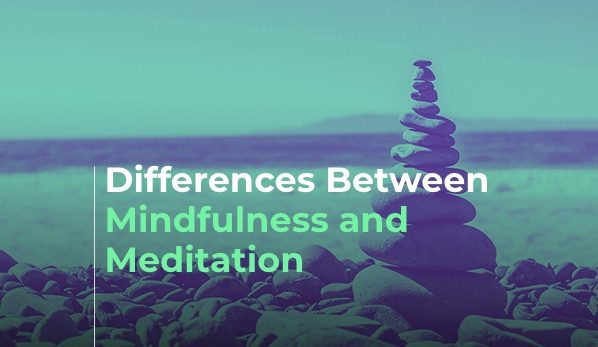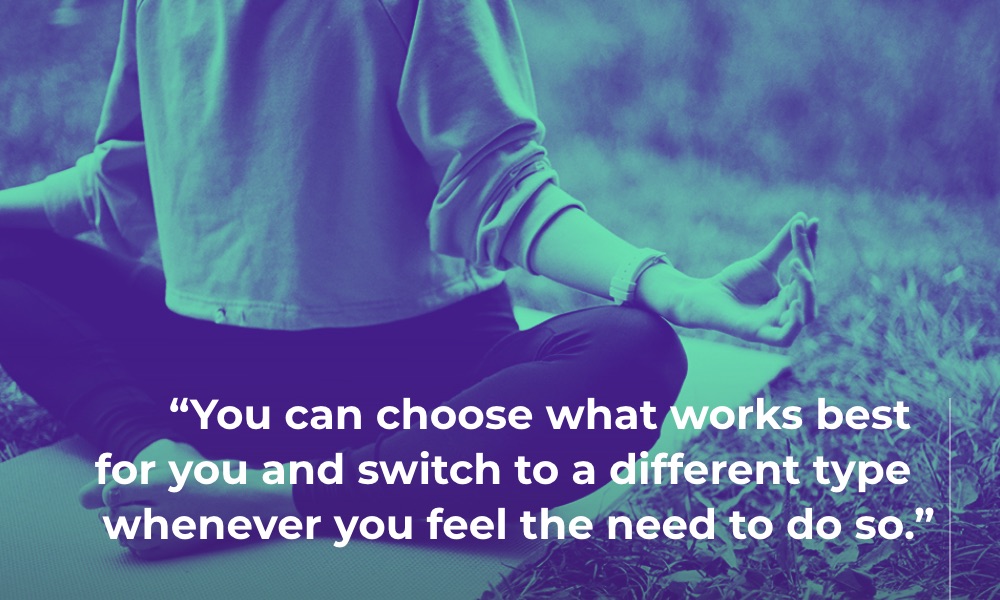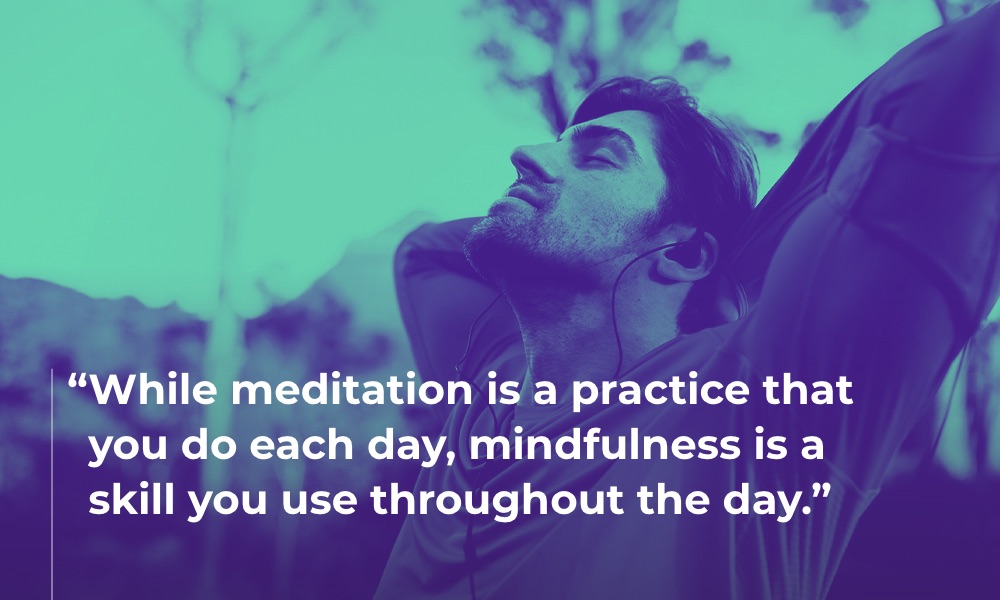If you’ve spent any time meditating, you’ve likely heard the word “mindfulness.” While mindfulness and meditation are not the same thing, they do have similar qualities. Where meditation is the practice of focusing your attention on one thing for an extended time, mindfulness is the conscious awareness of the present moment.
Some people use meditation as a spiritual practice, while others adopt meditation to cultivate mindfulness. And other people use meditation to improve their mood at home and performance at work.
Regardless of how you use mindfulness and meditation in your life, you’re in the right place. Let’s explore mindfulness vs. meditation and discuss the similarities and differences between the two.
What is Meditation?
Meditation is a practice that helps you become an impartial observer of your own mind. Meditation as a practice is thought to have roots in Buddhism. In fact, it’s believed that The Buddha himself taught zen meditation. However, ancient
Vedic scripts also speak of meditation. These scripts are the foundation of yoga and Hinduism. The Vedas speak of mantra meditation as a form of transcendental meditation. Although meditation has spiritual origins, and some use it as a religious or spiritual practice, it does not have to have any religious connotation. You can meditate regardless of your religious beliefs.
Most meditation techniques involve directing your awareness to one area of focus to gain calm, clarity, and awareness.
There are many different types of meditation, but most people begin by practicing mindfulness meditation with a focus on their breath. To do this, they focus all of their attention on their breath, following each inhale and each exhale with their mind.
Contrary to popular belief, meditation is not about emptying your mind of all of your thoughts—that’s nearly impossible to do! It’s also not about getting rid of all of your negative emotions. Quite the opposite, in fact, since meditation asks you to sit with those feelings.
Basically, meditation is about training your brain to notice your thoughts and let go of the unhelpful ones. Meditation helps you realize that your thoughts are not facts, and you are not your thoughts. In other words, meditation helps you observe your thoughts rather than become them.
Types of Meditation
Although there are dozens of forms of meditation, some of the most common ones are mindful meditations. Here are a few examples:
Breathing Meditation
During a breathing meditation you direct all of your attention to each of your inhales and exhales. When distracting thoughts arise, you simply note them and then redirect your attention to your breath.
Body Scan Meditation
During a body scan meditation, you bring awareness to different parts of your body in turn. You may also try relaxing each part of your body as you come to it. When your mind wanders, you simply note where it’s gone to and then you return your focused attention to whatever part of the body you were observing.
Moving Meditation
During a moving meditation, you cultivate awareness of your body as it moves. This can be through jogging, Tai Chi, yoga, or simply walking from the couch to the fridge!
Loving-kindness Meditation
In a loving-kindness meditation, you mentally send kindness and compassion to yourself and others.
Guided Meditation
During a guided meditation, you follow the instructions provided to you by a meditation teacher to help you relax and tune in to your mind and body.
There’s no one-size-fits-all meditation practice that is going to work best for everyone. You can choose what works best for you and switch to a different type whenever you feel the need to do so. The most important thing is to find a practice that helps you observe your wandering mind with curiosity, rather than judgment.
Most people find the most success meditating when they turn it into a routine. This means meditating at the same time and in the same place every day. But you don’t have to limit yourself. You can also meditate any time you feel an emotion that you’d like to sit with and process, like overwhelm, stress, anger, or even happiness!
The best part is, you can reap the benefits of meditation in as little as just a couple of minutes per day.
Benefits of Meditation
There’s a nearly endless list of benefits to meditation. Here are some of the most commonly enjoyed ones:
- Regular meditators enjoy a reduction in anxiety over time.
- Those who practice meditation experience less stress than their peers who don’t meditate.
- Practitioners of meditation may notice an improvement in their problem-solving skills.
- People who meditate have improved work performance and job satisfaction.
- Those who meditate regularly may experience a reduction in pain.
- Meditation is also known to lower blood pressure.
What is Mindfulness?
Mindfulness is the practice of bringing all of your attention to the present moment. This means being conscious and aware of whatever you happen to be doing in that moment. For example, mindfulness may look like:
- Truly feeling the sensation of hot water on your skin in the shower
- Fully listening to your loved one when they are talking
- Directing all of your awareness to the sensation of your muscles moving as you take a walk
- Actually hearing the sounds of the birds chirping outside of your window
Eckhart Tolle, renowned mindfulness teacher and author of “The Power of Now,” says this of living in the present moment:
“All negativity is caused by an accumulation of psychological time and denial of the present. Unease, anxiety, tension, stress, worry – all forms of fear – are caused by too much future, and not enough presence. Guilt, regret, resentment, grievances, sadness, bitterness, and all forms of nonforgiveness are caused by too much past, and not enough presence.”
We all have the ability to be mindful, but it’s a skill we need to practice if we want to reap its mental health and physical health benefits. This is especially true in our modern age of constant text messages, emails, and push notifications—all designed to pull us away from what’s happening in the current moment.
How to Incorporate Mindfulness Into Your Day
In order to build mindfulness into a skill, you need to incorporate it into your day-to-day activities. Here are a few ways to do it:
- Pause between activities. It’s natural for us to pause between one activity (like answering emails) and another activity (like starting a report). However, many of us fill this natural pause with a quick glance at our phones or another distraction. Instead, try sitting with your breath or noticing the sensations in your body. You could even simply notice what’s going on in the room around you.
- Use a scented body care product. Try using scented products (like lavender lotion) and make a point of really noticing the smell each time you put it on.
- Anchor your mindfulness practice to a trigger. For example, every time you flip on a light switch, let it remind you to return your attention to the present moment.
- Go outside. You can go for a walk or just sit and pay attention to the sensations of nature. For example, notice the smells in the air, the warmth of the sun on your skin, or the sound of birds chirping.
- Cultivate awareness when you get into your bed. The end of the day is a great time to practice mindfulness. What do the pillows, blankets, and mattress feel like? How is your body sinking into the bedding?
Of course, one of the best ways to practice mindfulness is with meditation. Mindfulness meditation includes a large category of meditation practices designed to anchor you in the present moment.
Some of the most popular types of mindfulness meditation are the ones we discussed above: breathing meditation, moving meditation, loving-kindness meditation, and body scan meditation.
Because meditation uses mindfulness, many of the benefits of meditation and benefits of mindfulness are the same, including reduced stress and anxiety, a greater ability to focus, and an improved sense of well-being.
Differences Between Mindfulness and Meditation: Is Mindfulness Meditation?
Now that you understand how mindfulness and meditation relate to one another, let’s examine some of the differences between the two.
- While meditation is a practice that you do each day, mindfulness is a skill you use throughout the day. You can compare this to running and movement. Going for a run is a practice you might do each day, but it uses the skill of movement, which you cultivate and use throughout the day.
- You can use mindfulness without meditation. Nearly everything in life—from washing the dishes to giving a presentation at work—can be a practice in mindfulness. You don’t need to have a formal meditation routine to practice tuning into your present moment.
- Even though there are a large number of meditation practices, there are infinitely more ways to practice being mindful.
- You likely experience occasional moments of mindfulness throughout your daily life without trying to, but you typically can’t meditate without trying to. Thankfully, some experiences zap you fully into the present moment, even when you’re not actively trying to practice mindfulness. For example, when you jump into a freezing cold pool or eat an incredible dessert. However, it would be rare to go into a full-on meditative state unintentionally.
- Although both are very accessible, many may find mindfulness easier to start with. Because meditation is a formal practice and mindfulness is not (necessarily), those starting to improve their well-being may gravitate toward general mindfulness before adding a meditation routine.
Mindfulness or Meditation: Which is Right for You?
So which is better for you, mindfulness or meditation? The answer is both! They work in harmony to help you achieve a greater sense of well-being and experience a host of benefits.
Plus, you cannot meditate without mindfulness, so if you’ve chosen meditation, you’ve automatically chosen mindfulness, too.
However, if you find the practice of meditation to be too overwhelming at first, start by practicing some mindfulness. You can try some of the mindfulness tricks we’ve mentioned above, like really feeling the sun on your skin when you go outside. Chances are, you’ll feel so good that meditation will be a natural next step.
Both of these practices make excellent complements to other mental health practices, such as mindfulness-based cognitive therapy and mindfulness-based stress reduction.
Using Primed Mind for Meditation and Mindfulness
Primed Mind is a meditation app designed to help you cultivate a healthier state of mind and find inner peace through 5–20 minute sessions. Created by some of the world’s top mindset coaches and easy to fit into your self-care routine,
Primed Mind has primers that help root you in the present moment, like our:
- Be a Better Listener primer
- Mindfulness Flow primer
- Be in the Moment primer
Get started with Primed Mind for free today, or read our article on How to Meditate for even more tips to incorporate mindfulness and meditation into your everyday life!




